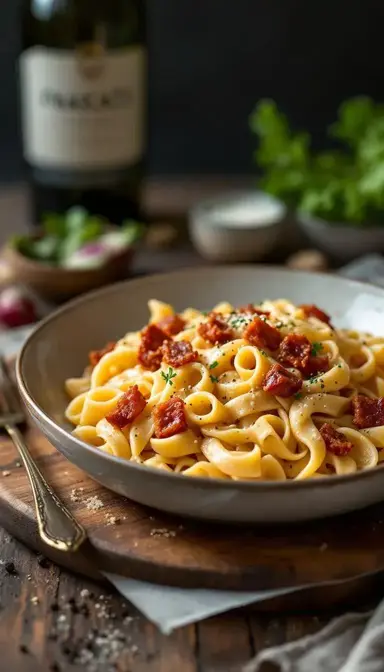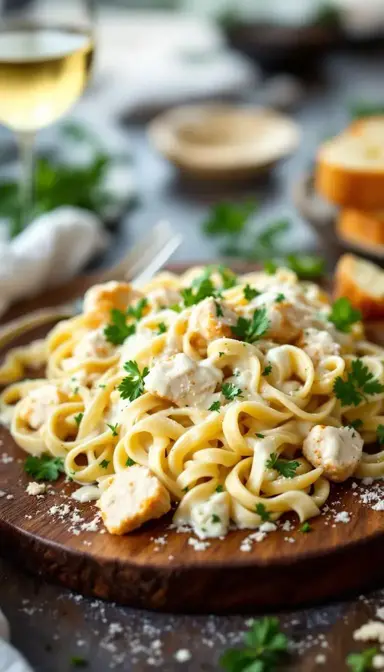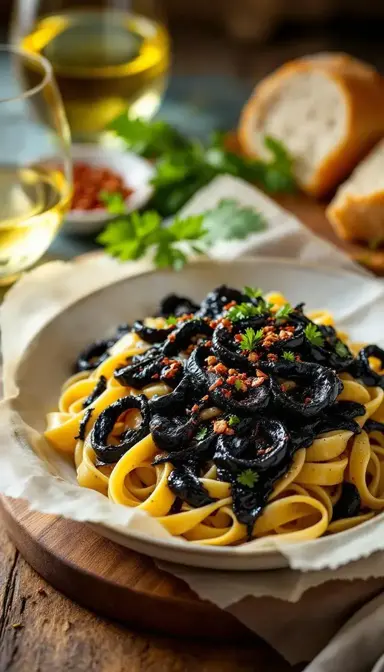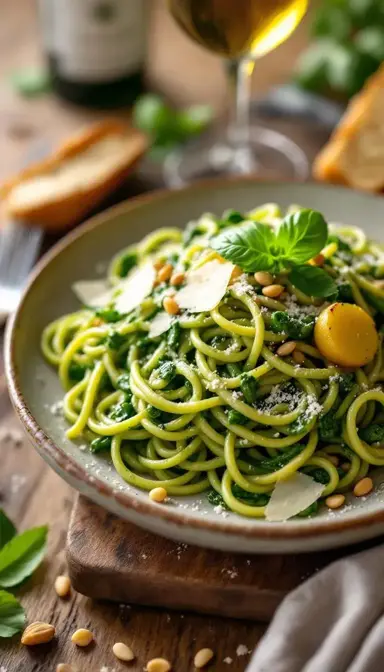There’s something almost sacred about the way golden cubes of guanciale sizzle in a well-worn skillet, their fat slowly melting into liquid gold. The sharp, salty bite of Pecorino Romano, the warmth of freshly cracked black pepper, and the way starchy pasta water works its magic—this is Pasta alla Gricia, the unsung hero of Roman cuisine.
I remember the first time I tasted it in a tiny trattoria near the Pantheon. The chef, a grizzled Roman nonna with forearms like tree trunks, tossed the pasta with such confidence that I knew I was about to experience something special. One bite and I was hooked—this was simplicity perfected.
Now, after years of cooking (and eating) my way through Rome, I’m sharing the secrets to making Pasta alla Gricia the way it’s meant to be. No fuss, no fancy techniques—just four incredible ingredients and a little know-how.
Why This Recipe Works
- Four ingredients, infinite flavor: Guanciale, Pecorino, pepper, and pasta—that’s it. No frills, no fillers.
- Faster than ordering takeout: From pan to plate in 25 minutes flat.
- The foundation of Roman pasta: Master this, and Carbonara and Amatriciana become second nature.
- A lesson in emulsification: The magic of starchy water turning fat and cheese into silk.
The Story Behind the Sauce
Before tomatoes made their way to Italy, before Carbonara was even a twinkle in a Roman cook’s eye, there was Pasta alla Gricia. Born in the hills of Lazio, this was the food of shepherds—simple, hearty, and designed to fuel long days. Some say its name comes from the Roman bakers (*grici*), others from the village of Grisciano. Whatever its origins, one thing’s certain: this dish is a testament to the power of restraint.
Essential Ingredients & Tools
Ingredients
- 150g (5 oz) guanciale: Cured pork jowl, diced (pancetta works in a pinch, but avoid bacon—its smokiness overpowers).
- 100g (1 cup) Pecorino Romano: Finely grated (Parmigiano-Reggiano can mellow the saltiness if preferred).
- 1–2 tsp coarsely ground black pepper: Freshly cracked for maximum aroma.
- 400g (14 oz) dried pasta: Rigatoni or bucatini (their ridges trap sauce; spaghetti works too).
Tools You’ll Need
- 12-inch skillet: Carbon steel or cast iron for even heat (a non-stick pan will work but won’t develop the same fond).
- Box grater or Microplane: For finely grating the cheese (a zester can substitute in a pinch).
- Tongs or a fork: To toss the pasta vigorously (wooden spoons work but won’t emulsify as effectively).
Serves: 4 | Prep time: 10 mins | Cook time: 15 mins
How to Make Pasta alla Gricia
1. The Guanciale Ritual
Dice the 150g (5 oz) guanciale into ½-inch cubes—uniformity ensures even crisping. Pro tip: Freeze it for 10 minutes first; it firms up for cleaner slicing. Unlike bacon, guanciale’s fat renders slowly, creating a silky base.
2. The Slow Render
Place the 150g (5 oz) guanciale in a cold skillet, then turn the heat to medium-low. This gradual rendering prevents burning and maximizes fat yield. Stir occasionally until golden and crisp (about 8 minutes). Reserve the crispy bits and every drop of fat—this is liquid gold.
3. The Cheese Alchemy
While the guanciale cooks, mix the 100g (1 cup) Pecorino Romano, 1–2 tsp coarsely ground black pepper, and 2 tbsp cold water into a thick paste. This *pre-hydrates* the cheese, preventing clumping later. Key insight: The water activates the cheese’s emulsifiers for a smoother sauce.
4. Pasta, Perfectly Timed
Boil the 400g (14 oz) dried pasta in heavily salted water (like the Mediterranean) until 1 minute shy of al dente. Reserve 2 cups of starchy pasta water—this is critical for the sauce’s texture.
5. The Magic of Mantecatura
Over low heat, toss the pasta with the reserved fat and ½ cup pasta water, stirring aggressively. The starch binds with the fat, creating a creamy emulsion. Remove from heat before adding the cheese paste—high heat makes Pecorino grainy. Toss for 1–2 minutes, adding water as needed until the sauce clings like velvet.
6. The Grand Finale
Fold in the crispy guanciale, reserving some for garnish. Plate immediately, showering with extra Pecorino and pepper. Serve in warm bowls—cold dishes cause the sauce to seize.
Chef’s Wisdom
Why Cold Pan for Guanciale?
Starting cold lets the fat render slowly, like butter melting over warm toast. Rush it, and you’ll end up with tough, chewy bits instead of crispy, melt-in-your-mouth perfection.
The Cheese Trap
Ever had your sauce turn into a grainy mess? That’s heat murdering your Pecorino. Always take the pan off the burner before adding the cheese—let residual heat do the work.
Storage & Freshness Guide
Store in an airtight container for up to 2 days. Reheat gently in a skillet with 1–2 tbsp water to revive the emulsion. Microwaving will overcook the cheese.
Perfect Pairings
Complementary Dishes
- Radicchio Salad
Bitter radicchio, dressed with lemon and olive oil, cuts through the pasta’s richness. The crunch contrasts the silkiness. - Garlicky Broccolini
Sautéed with chili flakes and garlic, it adds a verdant, spicy counterpoint.
Drinks
- Frascati Superiore
This crisp Roman white wine has bright acidity to balance the fat, with subtle almond notes that mirror Pecorino’s savoriness. - Negroni Sbagliato
A lighter take on the Negroni, with prosecco’s effervescence cleansing the palate.
Something Sweet
- Olive Oil Gelato
A scoop of fruity, herbal gelato echoes the dish’s peppery finish. - Honey-Drizzled Ricotta
Creamy ricotta with wild honey and toasted pine nuts offers a gentle, sweet finale.
FAQs
Q: Can I use bacon?
A: Only in emergencies—its smoke overpowers. Pancetta is a better substitute.
Q: Why is my sauce grainy?
A: Pre-grated cheese or adding cheese to a too-hot pan. Always grate fresh and cool the skillet slightly.
Q: Can I freeze it?
A: No—the emulsion breaks upon thawing.

Pasta alla Gricia: Rome’s Humble Masterpiece That Will Change Your Pasta Game Forever
Learn how to make authentic Pasta alla Gricia with just four ingredients! This Roman classic is rich, peppery, and ready in 25 minutes. Try it tonight!
Ingredients
-
150 g guanciale (diced)
-
100 g Pecorino Romano (finely grated)
-
1–2 tsp coarsely ground black pepper
-
400 g dried rigatoni or bucatini
Instructions
-
Dice 150g (5 oz) guanciale into ½-inch cubes. Freeze for 10 minutes for easier slicing.01
-
Render guanciale in a cold skillet over medium-low heat until crisp (8 mins). Reserve fat and crispy bits.02
-
Mix 100g (1 cup) Pecorino Romano, 1–2 tsp coarsely ground black pepper, and 2 tbsp cold water into a paste.03
-
Cook 400g (14 oz) dried pasta in salted water until 1 minute shy of al dente. Reserve 2 cups pasta water.04
-
Toss pasta with reserved fat and ½ cup pasta water over low heat. Remove from heat, add cheese paste, and toss until creamy.05
-
Fold in crispy guanciale. Serve immediately with extra Pecorino and pepper.06



